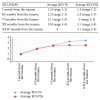The Biological Metallic versus Metallic Solution in Treating Periprosthetic Femoral Fractures: Outcome Assessment
- PMID: 27990462
- PMCID: PMC5136380
- DOI: 10.1155/2016/2918735
The Biological Metallic versus Metallic Solution in Treating Periprosthetic Femoral Fractures: Outcome Assessment
Abstract
Introduction. The periprosthetic fracture of the femur is, in order of frequency, the fourth leading cause (5.9%) of surgical revision. Our study aims to demonstrate how the grafting of bone splint betters the outcomes. Materials. We treated 15 periprosthetic femoral fractures divided into two groups: PS composed of 8 patients treated with plates and splints and PSS involving 7 patients treated only with plates. The evaluation criteria for the two groups during the clinical and radiological follow-up were the quality of life measured by the Short Form (36) Health Survey (SF-36), Harris Hip Score (HHS), Modified Cincinnati Rating System Questionnaire (MCRSQ), bone healing measured by the Radiographic Union Score (RUS), postoperative complications, and mortality. The evaluation endpoint was set at 24 months for both groups (p < 0.05). Results. The surgery lasted an average of 124.5 minutes for the PS group and 112.6 minutes for the PSS. At 24 months all clinical and radiographic scores were p < 0.05 for the PS group. During follow-up 4 patients (2 in each group) died of causes not related to surgery. Conclusions. The use of the metal plate as opposed to cortical allogenic splint should be taken into consideration as a noteworthy point for periprosthetic femoral fractures.
Conflict of interest statement
All authors disclose no financial and personal relationships with other people or organizations that could inappropriately influence (bias) their work. Examples of potential competing interests include employment, consultancies, stock ownership, honoraria, paid expert testimony, patent applications/registrations, and grants or other funding.
Figures




Similar articles
-
The challenge of non-union in subtrochanteric fractures with breakage of intramedullary nail: evaluation of outcomes in surgery revision with angled blade plate and allograft bone strut.Eur J Trauma Emerg Surg. 2017 Dec;43(6):853-861. doi: 10.1007/s00068-016-0755-5. Epub 2017 Mar 3. Eur J Trauma Emerg Surg. 2017. PMID: 28258285
-
[Periprosthetic Femoral Fractures after Total Hip Replacement: Our Results and Treatment Complications].Acta Chir Orthop Traumatol Cech. 2017;84(1):52-58. Acta Chir Orthop Traumatol Cech. 2017. PMID: 28253947 Czech.
-
[Osteosynthesis for periprosthetic supracondylar fracture above a total knee arthroplasty using a locking compression plate].Acta Chir Orthop Traumatol Cech. 2009 Dec;76(6):473-8. Acta Chir Orthop Traumatol Cech. 2009. PMID: 20067694 Czech.
-
Functional and radiological outcome of periprosthetic femoral fractures after hip arthroplasty.Injury. 2015 Feb;46(2):292-8. doi: 10.1016/j.injury.2014.07.013. Epub 2014 Jul 19. Injury. 2015. PMID: 25085599 Review.
-
Similar outcomes of locking compression plating and retrograde intramedullary nailing for periprosthetic supracondylar femoral fractures following total knee arthroplasty: a meta-analysis.Knee Surg Sports Traumatol Arthrosc. 2017 Sep;25(9):2921-2928. doi: 10.1007/s00167-016-4050-0. Epub 2016 Feb 20. Knee Surg Sports Traumatol Arthrosc. 2017. PMID: 26897137 Review.
Cited by
-
Interprosthetic and interimplant femoral fractures: is bone strut allograft augmentation with ORIF a validity alternative solution in elderly?Orthop Rev (Pavia). 2022 Oct 13;14(6):38558. doi: 10.52965/001c.38558. eCollection 2022. Orthop Rev (Pavia). 2022. PMID: 36267217 Free PMC article.
-
The challenge of nonunion after osteosynthesis of the clavicle: is it a biomechanical or infection problem?Clin Cases Miner Bone Metab. 2017 Sep-Dec;14(3):372-378. doi: 10.11138/ccmbm/2017.14.3.372. Epub 2017 Dec 27. Clin Cases Miner Bone Metab. 2017. PMID: 29354171 Free PMC article.
-
The challenge of non-union in subtrochanteric fractures with breakage of intramedullary nail: evaluation of outcomes in surgery revision with angled blade plate and allograft bone strut.Eur J Trauma Emerg Surg. 2017 Dec;43(6):853-861. doi: 10.1007/s00068-016-0755-5. Epub 2017 Mar 3. Eur J Trauma Emerg Surg. 2017. PMID: 28258285
-
Treatment of periprosthetic knee infection and coexistent periprosthetic fracture: A case report and literature review.World J Clin Cases. 2023 Apr 6;11(10):2321-2328. doi: 10.12998/wjcc.v11.i10.2321. World J Clin Cases. 2023. PMID: 37122513 Free PMC article.
-
Open reduction and locked compression plate fixation, with or without allograft strut, for periprosthetic fractures in patients who had a well-fixed femoral stem: a retrospective study with an average 2-year follow-up.BMC Musculoskelet Disord. 2022 Jan 19;23(1):69. doi: 10.1186/s12891-022-05008-2. BMC Musculoskelet Disord. 2022. PMID: 35045862 Free PMC article.
References
-
- Della Corte S., Crispino V., Iavarone M., et al. The Periprosthetic fractures, Epidemiology and treatment: our experience. AITOG OGGI. 2013;2:26–31.
-
- Berry D. J. Epidemiology of periprosthetic fractures after major joint replacement: hip and knee. Orthopedic Clinics of North America. 1999;30:183–190. - PubMed
-
- Masri B. A., Meek R. M. D., Duncan C. P. Periprosthetic fractures evaluation and treatment. Clinical Orthopaedics and Related Research. 2004;420:80–95. - PubMed
LinkOut - more resources
Full Text Sources
Other Literature Sources

